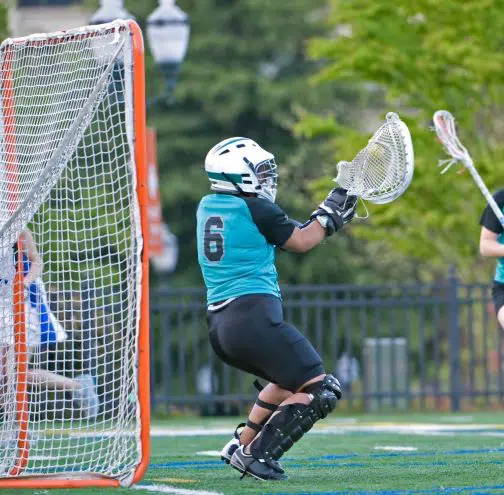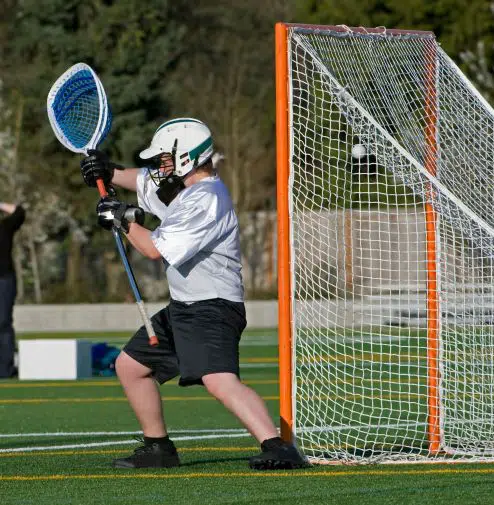Lacrosse has many challenging features. There is the pace, the ferocity of the shots, the physical challenges – and so many more!
But out of all of this what is the hardest position?
The goalkeeper is the hardest position in lacrosse. You face the fastest shots, you usually receive the most bruises and injuries, and the whole team is counting on you during a few high-intensity moments of every match.
There are other positions in lacrosse that have their own challenges, but I definitely think that taking the whole picture into account the goalie comes out on top.
That’s not to say that there are not tremendous positives and benefits to playing as the goalie – there definitely are!
But read on to find out all the pitfalls, all the challenges, and all the issues you will face in this key position.

The Hardest Positions In Lacrosse – The Possible Contenders
Lacrosse is fast-moving, and a sport that places great emphasis on players being assigned to specific zones (or positional play).
These positions can be divided into four major categories (and each of these has its own difficulties): namely, attacking players, midfield players, defensive players, and goalkeepers.
For women’s lacrosse, two extra attacking players are fielded to make for more versatile plays, with the offensive plays being carried out by five players rather than just three.
To get specific, there are many positions in lacrosse, with most teams running so many midfielder positions that even having a top 5 for hardest positions can seem daunting.
However, while many would argue on the fourth, third, or even second hardest positions, you’d be hard-pressed to find someone who would disagree with the hardest position in lacrosse is that of the goalie.
The Goalkeeper Stands Out
The final defense player in lacrosse is the goalkeeper.
The goalie needs a solid physical presence and extremely fast reaction time as they’re the final guard against oncoming attacking players who have made it past the defense and are headed straight for the goal.
Goalies may have to order the defense into the most optimal positions to block or repel the opposition’s attacks.
We can list a million angles (no pun intended) from which being the goalie is tough, but here are the seven most compelling arguments for why the hardest position in lacrosse is that of the goalkeeper.
1. You Face The Most Shots
As a lacrosse goalie, the action you can be expected to see in terms of pure shots per hour might just have the highest ratio out of all the sports, including hockey and soccer – which you can think of as the two ends of the spectrum.
Why?
Hockey involves a ridiculously high save percentage – the lowest save percentage of any team in the NHL in 2016 was a whopping 89.2%.
It’s pretty much the job description of a hockey goalie, making saves.
2. The Goalie is The Last Line of Defense
The goalie, being the last line of defense in a game, can make or break a whole play, and a whole game.
The speeds the ball can travel at and the close ranges at which shots can be made make it nerve-racking, and ultimately, the ball is in your court, so to speak, to have it all be in vain as you allow a shot to the back of the net.
You’re scored on frequently, and it can be mentally taxing if you let each shot get to you and throw you off your zen.
3. Your Chances Are Slimmer
The parameters that you’re playing with as a lacrosse goalie are much different than those for any other game.
If something seems better on the surface, the corresponding factors more than make up for it and contribute to the position being much more difficult overall.
Your chances of making a save are much slimmer with both the size of the goal and the tools you’ve been given to work with.
A hockey net is 24 square feet. A lacrosse goal? 36 square feet. This means the area to cover is larger, and the players have more space to get the shots in.
This puts more pressure on the goalie and renders making a save all the more harder, and makes the position the hardest relative to other players in the same game, and the same position across different sports.
Additionally, when it comes to protection, the lacrosse gods are vengeful yet again.
Lacrosse goalies have gloves, a helmet with a throat guard, and a stick. You’ll notice that what’s conspicuously missing… is pads for your arms – or literally anywhere else – that you’d expect in another sport such as hockey
4. The Science Backs It Up
ESPN’s popular Sports Science series have included an installment on the science of being a lacrosse goalie. (Source)
The data speaks for itself, using technology to pretty much conclusively prove that being a lacrosse goalie is like pitting yourself against the established laws of physics and the limitations of being a human.
The fastest a human being is able to react, according to the ESPN study, to a visual stimulus is 200 milliseconds.
For a lacrosse goalie, there’s a time span of 190 milliseconds before a shot at 105mph reaches the goal from 30 feet away. The time gets faster if the distance is closer (let’s say 20 feet) even if the shot is slower (let us say 80mph), meaning around 170 milliseconds.
In any other sport – such as baseball – the same equivalent of these numbers would be considered too hot to handle, even impossible.
Luckily, you’re only expected to have a save percentage of around 50% in lacrosse, but that might be because anything above that seems like it would have to be considered superhuman.

5. You Face The Fastest Shots
The low-scoring sport of soccer seems tame in comparison even to hockey, with an average shot being just around 60mph.
There’s a wider net, sure, but you face far fewer shots. Lacrosse, however, sees recorded speeds of up to 114mph for a lacrosse shot (compare to the fastest hockey shot recorded in history – 110 mph).
With improvements in equipment, year on year, average shot speeds continue to climb. (Source)
The average shot recorded is around 80mph and the travel speed of the ball itself can easily reach 100mph.
These are just raw statistics, and yet we can already see the dangerous territory we’re in.
6. The Entire Team Counts On You
It’s more or less taken for granted that the goalie knows where the ball is at any given time and where the ball is going.
The goalkeeper’s position is the one that has to be the most alert and pay attention to the game with an eagle eye, knowing where all the defensemen are supposed to be, as well as the offensive leanings of where the game stands at any moment in time.
Asking the team will yield unsurprising answers that back up the importance of the goalkeeper.
A simple forum poll showed the goalie being voted on as the hardest position to play by an overwhelming majority.
While everyone naturally understands their position well (and, of course, better than another’s), they still understand, acknowledge, and appreciate the importance, difficulty, and strife of the goalkeeper.
If the science doesn’t solidify the goalkeeper being the hardest position in lacrosse, the testimony of the players of the sport itself should!
7. The Injuries And The Bruising
We could probably leave this section as it is – and especially for those who’ve been playing lacrosse even for a little while, even if they’re not in the goalkeeper position, it really will be self-explanatory.
Being a lacrosse goalkeeper means being used to hosting a collection of blue, green, purple, and yellow bruises all over your body, with shots being fired fast in your general direction.
Goalies compare it to being punched. It’s as if you were being punched all over the body without any protection. Even with shin guards, for example, which are required for high school girls’ lacrosse, the phenomenon of accumulated scarring does its work and leaves its mark.
A Round of Applause
Many lacrosse goalies would tell you that people look at them as if they’re crazy when they tell them the position they play.
It’s the hardest position, one that demands respect, awe, and appreciation, whether it’s at the high school level, college, major league, men’s, women’s, anything – the lacrosse goalkeeper is one tough nut.
